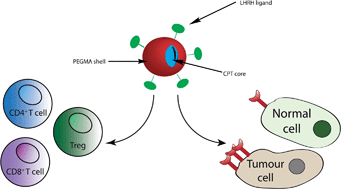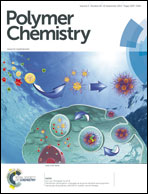Camptothecin prodrug block copolymer micelles with high drug loading and target specificity†
Abstract
The clinical efficacy of cytotoxic drugs in the treatment of cancer is often hampered by poor pharmacodynamics and systemic toxicity. Here, we describe the design and synthesis of a new PEG-based system for the delivery of the cytotoxic camptothecin (CPT) into tumor cells that overexpress luteinizing hormone releasing hormone receptor (LHRHR). A novel functional reducible camptothecin (CPT) block copolymer conjugate was prepared using atom transfer radical polymerization (ATRP). The use of ATRP in the design and synthesis of the copolymer prodrug facilitated high drug loading and specific delivery to tumor cells. The efficacy of the polymer conjugate was evaluated in appropriate cancer cell lines in vitro. Cytotoxic potency was comparable to that of free CPT in LHRHR positive cell lines after 72 hours, whereas little cytotoxicity was observed in LHRHR negative lines. The study also evaluated the effects of polymer-based therapeutics on human peripheral blood mononuclear cells (PBMC). Free CPT demonstrated indiscriminate toxicity against the immune cells, with impairment of PBMC proliferation and a reduction in CD8+, CD4+ T cell populations. The camptothecin (CPT) block copolymer demonstrated a significant improvement in cell proliferation and maintenance of CD8+ cells.


 Please wait while we load your content...
Please wait while we load your content...